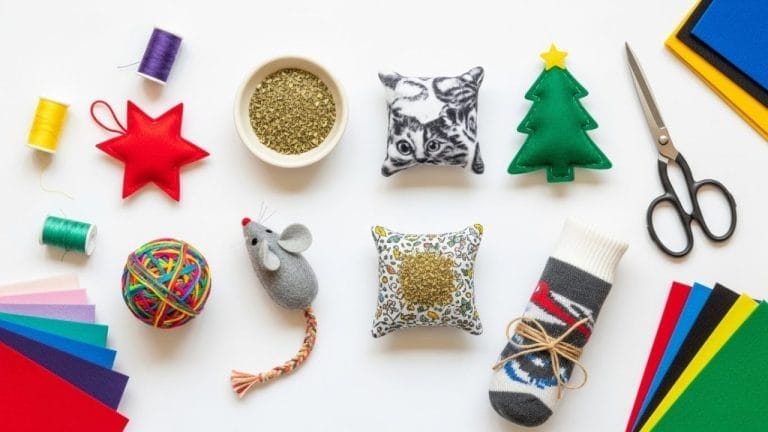7 DIY Cat Wall Furniture Ideas That’ll Make Your Cat Climb With Joy
Cats love to climb, perch, and rule their kingdom from above. If you don’t give them vertical space, they’ll take over your shelves and curtains anyway.
That’s where cat wall furniture comes in. With a few simple DIY projects, you can turn your walls into the ultimate playground.
It’s fun, it saves floor space, and your cat will think you just built them a private amusement park.
7 DIY Cat Wall Furniture Ideas
1. The Floating Cat Steps
These shelves turn a boring wall into a climbing playground. Cats can use them to reach higher ground, chase each other, or just sit and watch the room from above.
What makes it unique: Unlike bulky cat towers, this takes almost no floor space. It’s neat, modern, and your cats will feel like little ninjas leaping from step to step.
How to copy it:
- Buy or cut wooden boards about 10–14 inches wide so your cat has enough room to land comfortably.
- Cover the top with carpet squares or a strip of sisal so their paws won’t slip.
- Mount the shelves into studs with strong L-brackets. Don’t trust drywall anchors — cats will knock those out eventually.
- Arrange the steps like a staircase so cats can hop up without straining. Start with the first one low, then build up toward a higher perch or cat condo.

By the way, if you're into DIY Hacks stuff, you’ll wanna check this one out: 20+ DIY Cat Christmas Gifts You Can Actually Make
2. The Cat Hammock Wall
This design mixes platforms with stretched fabric hammocks. It gives your cat choices: climb when they’re active, sink into the hammock when they’re lazy.
What makes it unique: The hammock adds coziness. Cats love soft dips where they can curl up, but this setup also looks stylish — almost like modern shelving with fabric accents.
How to copy it:
- Use durable fabric like canvas, denim, or outdoor upholstery material. Thin fabric won’t hold up.
- Attach the hammock ends to wooden dowels or flat bars, then screw those onto brackets mounted on studs.
- Place hammocks at different heights with flat shelves in between so cats can jump or lounge.
- Bonus: use removable fabric so you can toss it in the wash when fur and claws take their toll.
Oh, and speaking of DIY Hacks, here’s another one you might like: 10 DIY Cardboard Christmas House Ideas for Cats
3. The Wall Bridge Adventure
This design looks like a mini cat parkour course. Small steps climb up one side, leading to a suspended rope-style bridge, and finally end at a cozy wall-mounted box.
What makes it unique: It challenges your cat’s balance. The bridge sways slightly when they walk across, giving them an exciting test of coordination. The box at the end feels like a reward — a private little fort where they can nap or spy on you.
How to copy it:
- Build a set of wooden steps about 8–12 inches apart, mounted at an upward angle.
- Create a bridge using wooden planks connected with rope or heavy-duty straps. Space the planks a little so light passes through.
- Mount a cube or enclosed shelf at the end with a round cutout entrance. Line the inside with fleece or a cushion.
- Keep everything close enough that cats don’t need superhero leaps, but far enough that it keeps them moving.
Also, just throwing this in—this DIY Hacks post is a fun read too: Make Your Cat’s Christmas: Easy DIY Catnip Toys They’ll Go Nuts For
4. The Indoor Cat Jungle
This wall combines climbing shelves, fabric ramps, and hammocks with hanging plants. It’s not just a cat playground — it doubles as part of your home decor.
What makes it unique: It looks like a living piece of art. The greenery gives it a jungle vibe, and your cats get to climb through “foliage” like wild explorers. Guests will think you designed it for the house, not just the pets.
How to copy it:
- Install staggered shelves and hammocks up one side of a wall.
- Use safe plants like pothos, spider plants, or cat grass. Avoid lilies, aloe, or anything toxic.
- Let vines trail down near the climbing area so it blends naturally.
- Add vertical scratching posts wrapped in sisal rope between the steps so cats can pause for a stretch.
5. The Rustic Tree Tower
This setup uses natural wood poles wrapped in sisal with wicker baskets as lounging bowls. It looks handmade and blends beautifully with a boho or rustic room.
What makes it unique: Instead of the usual carpet-covered towers, this feels earthy and warm. The baskets give cats a cozy nest, while the rope-wrapped poles double as scratching posts.
How to copy it:
- Find thick, sturdy branches or wooden poles. Strip the bark and sand them smooth.
- Wrap sections in sisal rope for scratching.
- Attach wicker baskets to the top of poles with screws and metal brackets. Add a soft pillow or blanket inside.
- Mount the poles to a heavy wooden base so the structure won’t wobble.

6. The Stairway Playground
This design transforms a whole wall into a cat obstacle course. Steps, ramps, and walkways zig-zag up the wall, giving endless routes for exploration.
What makes it unique: It’s not just one path — it’s a full climbing maze. Cats can run across, sneak around, and even nap mid-way. If you’ve got multiple cats, they can chase each other without fighting for space.
How to copy it:
- Cut small wooden planks about 8 inches deep for steps.
- Cover the tops with carpet for grip.
- Mount them in a zig-zag pattern up the wall. Add long flat ramps across sections for running.
- Use wide planks for walkways so two cats can pass each other without conflict.

7. The Honeycomb Cat Cubes
A modern twist, this design stacks hexagonal shelves in a honeycomb pattern. Cats can climb inside, perch on top, or peek through the cut-out holes.
What makes it unique: It doubles as modern art. The geometric shapes give your wall a stylish look, while cats get plenty of hiding and climbing space.
How to copy it:
- Build hexagon frames out of plywood. Make each side around 12–14 inches long so cats fit comfortably.
- Cut holes in a few sides for entry points.
- Paint or stain them to match your room.
- Mount several together on the wall in a beehive layout. Stack them vertically for climbing or horizontally for lounging.










